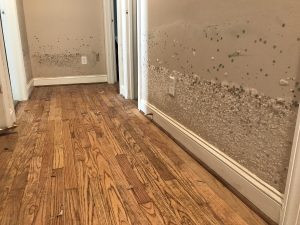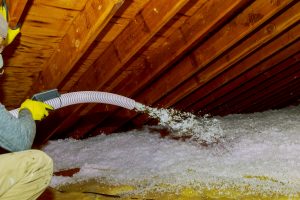Ice dams are among the most destructive winter phenomenon, but most homeowners are not aware of what they are and what causes them, let alone how to tell if they have them. But keeping a vigilant eye out this winter for ice dams forming along your roof can save you a lot of money in expensive water damage repair. Read on to learn more about ice dams—what they are, why they are so dangerous, and how to tell if your home has them. We’ll also provide some helpful tips for getting rid of any ice dams you discover around your home this winter.
What Are Ice Dams?
Ice dams are ridges of ice most often found along the edge of your roof that form when melted snow trickles down your roof and refreezes once it reaches the overhang. Initially, ice dams begin as seemingly harmless icicles that grow into a megalith-like block of ice that grows over the gutters and reaches back onto the roof. As heat escapes the attic and melts snow on the roof, water collects behind these dams. With nowhere else to go, this water will back up underneath your shingles and flow into your home, often down along the inside of the walls.
Why Are They a Problem?
 Water intrusion caused by ice dams often goes unnoticed for a long time, until the water damage is significant enough to come through the interior walls. Unlike roof leaks, which drip puddles into the middle of a room, the water from ice dam leaks flows down and into the walls, where it will soak through the studs and insulation until it finally shows up on the walls themselves, often accompanied by a major mold problem. Ice dam leaks can cause major damage to your roof, roof decking, interior walls, and insulation.
Water intrusion caused by ice dams often goes unnoticed for a long time, until the water damage is significant enough to come through the interior walls. Unlike roof leaks, which drip puddles into the middle of a room, the water from ice dam leaks flows down and into the walls, where it will soak through the studs and insulation until it finally shows up on the walls themselves, often accompanied by a major mold problem. Ice dam leaks can cause major damage to your roof, roof decking, interior walls, and insulation.
In addition to the leaks they cause, ice dams are incredibly heavy, weighing a few hundred to a few thousand pounds. Your roof is not designed to support this immense weight, especially at the edges. Unchecked ice dams have the potential to seriously damage your roof, roof decking, and shingles because of this.
How to Tell If You Have Ice Dams
Most ice dams form along the edges of your roof. Why? Because as heat escapes your through your attic, it melts the snow of the roof above. This water trickles down, shedding as water normally would, but when it reaches the much colder overhang, the water will refreeze as ice. So, keep an eye on any icicles forming along the edges of your roof, as these are the precursor to ice dams. Icicles that grow into the gutter and back onto the roof will need to be addressed quickly to prevent water damage to your home.
If you suspect you have ice dams, it’s always a good idea to check the attic for water stains along the edges of the roof. Water intrusion from ice dams seeps under the shingles, soaking down along the inside of your home’s walls. If you have ice dams, this will be the first place you’ll see signs of water damage.
How to Get Rid of Ice Dams
 While it is true that ice dams will eventually melt away on their own, the damage they may do to your home in the meantime warrants taking immediate action if you suspect you may have ice dams. To begin, you’ll want to manage icicles as they are forming, safely knocking them down as soon as you see them.
While it is true that ice dams will eventually melt away on their own, the damage they may do to your home in the meantime warrants taking immediate action if you suspect you may have ice dams. To begin, you’ll want to manage icicles as they are forming, safely knocking them down as soon as you see them.
If ice dams do form, it’s important to get rid of them as quickly as possible. Professional contractors have special steaming tools for removing ice dams quickly without damaging your roof. Before calling in the professionals, however, you can try creating a channel that will allow the water behind the dam to drain down to the gutter. To do this, you can fill a sock with ice melt and position it vertically along the edge of your roof. For dams larger than 3-4 feet, repeat every 2-3 feet.
Preventing Ice Dams from Forming

The best way to tackle ice dams is to prevent them from forming in the first place. It’s important to properly clean your home’s gutters as we head into winter. This ensures any water reaching your gutters this winter will be able to flow down the gutters and downspouts and be directed away from your home. Otherwise, water will collect in your gutters, creating the foundation for a nasty ice dam.
Have you noticed that after a light snow the edges of your roof are the only areas where the snow doesn’t melt? If so, it’s a good bet that your attic is not properly insulated or ventilated, which is often the underlying cause of ice dams. If you’ve noticed this, it’s time to bring in a professional who can help you properly insulate and ventilate your attic. Doing so will not only prevent ice dams (and the resulting water damage), but it will also make your home more energy efficient, helping to keep your energy bills lower in the winter and the summer.
Aapex Construction & Restoration is Here to Help!
Have you noticed an abundance of icicles in past winters and want to avoid potentially catastrophic damage to your home this winter? Contact us today for a consultation to figure out what is causing ice dams around your home and how to fix it!
Related Articles
The Causes of Roof Ice Dams and How to Prevent Them
Commonly Overlooked Signs of Water Intrusion


